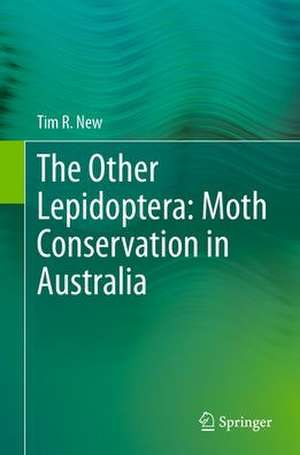The Other Lepidoptera: Moth Conservation in Australia
Autor Tim R. Newen Limba Engleză Hardback – 11 iul 2023
Conservation interest in moths, by far the predominant components of Lepidoptera, lags far behind that for butterflies, for which conservation practice provides many well-established lessons for extension to their near relatives. The needs of moths are at least as great, but their greater richness and variety, and far poorer documentation of diversity and biology over much of the world contribute to this lack of attention. Australia’s rich moth fauna, largely endemic and of global interest, illustrates many of the problems of developing wider interest and support for moth conservation. Numerous species (perhaps half the total fauna) are undescribed, and many are ecological specialists in restricted and vulnerable environments over small parts of the continent. Establishing their conservation status and needs whilst accepting that foundation knowledge is highly incomplete and much species-focused conservation is impracticable provides complex problems in setting priorities, based largely on wider diversity and effective advocacy. Most Australian vegetation systems, from grassland to forest and from sea-level to alpine zones, have been eroded in extent and quality since European settlement, resulting in massive habitat changes for native insects and to leave fragmented (and commonly degraded) remnants in which moths and others may persist. Recent surveys continue to increase recorded moth richness, reveal local faunal peculiarities, and indicate how assemblage changes may mirror wider environmental changes. This book is an overview of advances in documenting and interpreting moth diversity and ecology, to show how information from better-studied moth faunas can help in planning conservation of Australia’s moths through measures such as understanding the moths themselves by increased surveys and study, the factors influencing their diversity and wellbeing, and how such threats may be countered through increased coordinated conservation interest, commitment and management.
| Toate formatele și edițiile | Preț | Express |
|---|---|---|
| Paperback (1) | 777.65 lei 38-44 zile | |
| Springer International Publishing – 12 iul 2024 | 777.65 lei 38-44 zile | |
| Hardback (1) | 947.98 lei 6-8 săpt. | |
| Springer International Publishing – 11 iul 2023 | 947.98 lei 6-8 săpt. |
Preț: 947.98 lei
Preț vechi: 1156.07 lei
-18% Nou
Puncte Express: 1422
Preț estimativ în valută:
181.42€ • 196.99$ • 152.39£
181.42€ • 196.99$ • 152.39£
Carte tipărită la comandă
Livrare economică 22 aprilie-06 mai
Preluare comenzi: 021 569.72.76
Specificații
ISBN-13: 9783031321023
ISBN-10: 3031321022
Pagini: 227
Ilustrații: XIII, 227 p. 34 illus., 7 illus. in color.
Dimensiuni: 155 x 235 mm
Greutate: 0.52 kg
Ediția:2023
Editura: Springer International Publishing
Colecția Springer
Locul publicării:Cham, Switzerland
ISBN-10: 3031321022
Pagini: 227
Ilustrații: XIII, 227 p. 34 illus., 7 illus. in color.
Dimensiuni: 155 x 235 mm
Greutate: 0.52 kg
Ediția:2023
Editura: Springer International Publishing
Colecția Springer
Locul publicării:Cham, Switzerland
Cuprins
Chapter 1: Introducing moth variety and diversity.- Chapter 2: Moth ecology and conservation importance.- Chapter 3: Moth declines and the need for conservation.- Chapter 4: Causes for concern: habitat change as the major imposed threat to moths.- Chapter 5:Causes for concern: confounding threats to moths.- Chapter 6: Australia’s moths and their habitats.- Chapter 7: A closer focus: threats to Australia’s moths.- Chapter 8: Moth flagships in Australia: focus on single taxa.- Chapter 9: Conservation potential for Australia’s moths: focus on wider diversity.- Chapter 10: Bringing potential to practice: a future for Australia’s moths.
Notă biografică
Prof. Tim New is an entomologist with broad interests in systematics, ecology and conservation, and has published extensively in these areas. He is acknowledged widely as a leading advocate for insect conservation, and his books include several dealing with conservation of Lepidoptera. He is a past Editor-in-Chief of Journal of Insect Conservation and past Regional Editor of Biological Conservation, and has received several prestigious awards for his insect conservation work.
Textul de pe ultima copertă
Conservation interest in moths, by far the predominant components of Lepidoptera, lags far behind that for butterflies, for which conservation practice provides many well-established lessons for extension to their near relatives. The needs of moths are at least as great, but their greater richness and variety, and far poorer documentation of diversity and biology over much of the world contribute to this lack of attention. Australia’s rich moth fauna, largely endemic and of global interest, illustrates many of the problems of developing wider interest and support for moth conservation. Numerous species (perhaps half the total fauna) are undescribed, and many are ecological specialists in restricted and vulnerable environments over small parts of the continent. Establishing their conservation status and needs whilst accepting that foundation knowledge is highly incomplete and much species-focused conservation is impracticable provides complex problems in setting priorities, based largely on wider diversity and effective advocacy. Most Australian vegetation systems, from grassland to forest and from sea-level to alpine zones, have been eroded in extent and quality since European settlement, resulting in massive habitat changes for native insects and to leave fragmented (and commonly degraded) remnants in which moths and others may persist. Recent surveys continue to increase recorded moth richness, reveal local faunal peculiarities, and indicate how assemblage changes may mirror wider environmental changes. This book is an overview of advances in documenting and interpreting moth diversity and ecology, to show how information from better-studied moth faunas can help in planning conservation of Australia’s moths through measures such as understanding the moths themselves by increased surveys and study, the factors influencing their diversity and wellbeing, and how such threats may be countered through increased coordinated conservation interest, commitment and management.
Caracteristici
Up-to-date global survey of moth conservation, with much recent literature referenced Practical advice for conservation managers and non-specialist readers Foundation information and perspective for developing moth conservation in Australia
